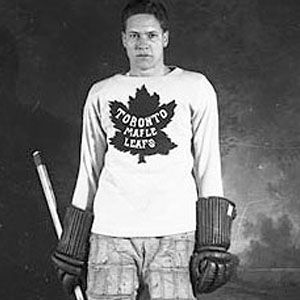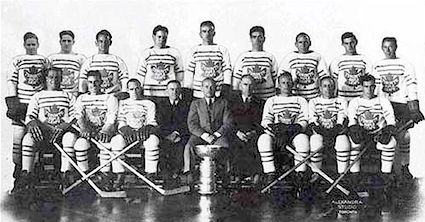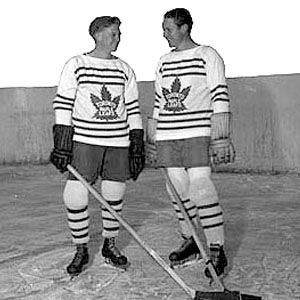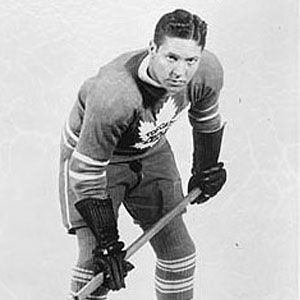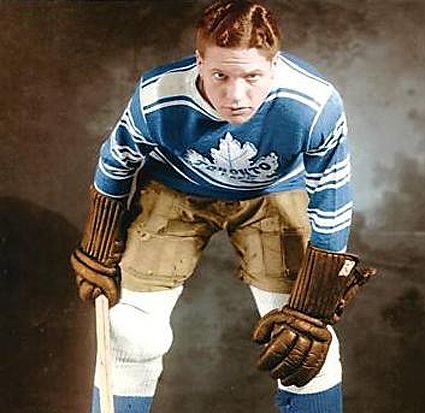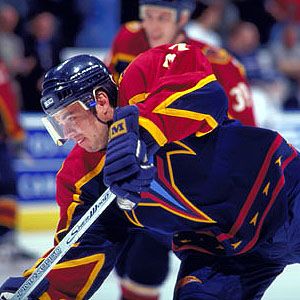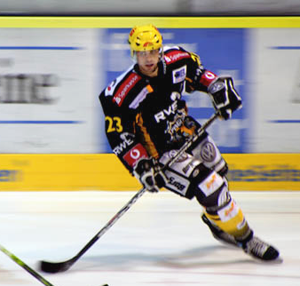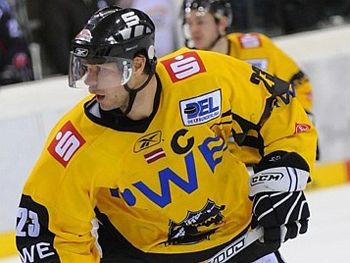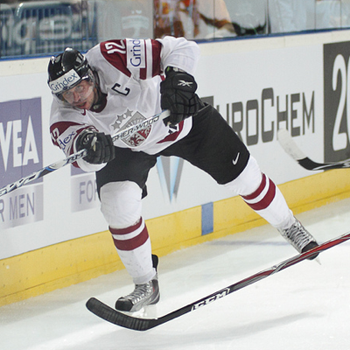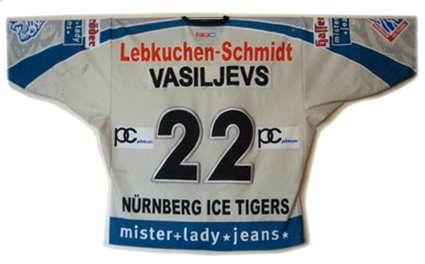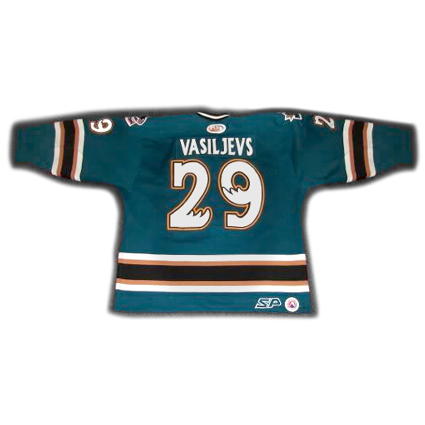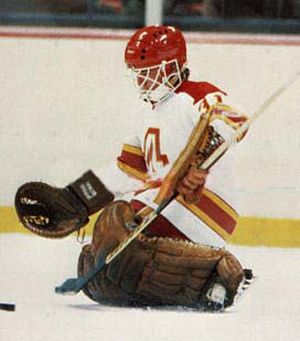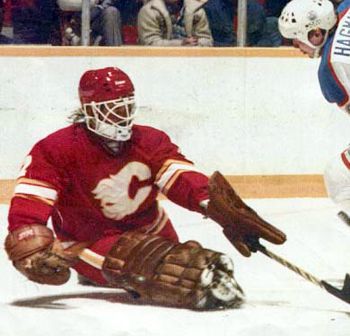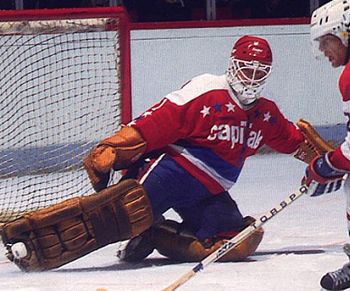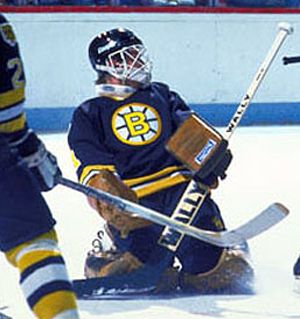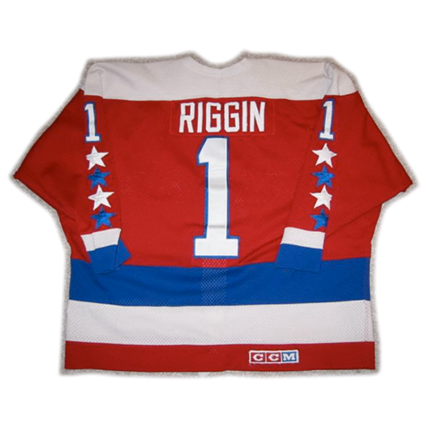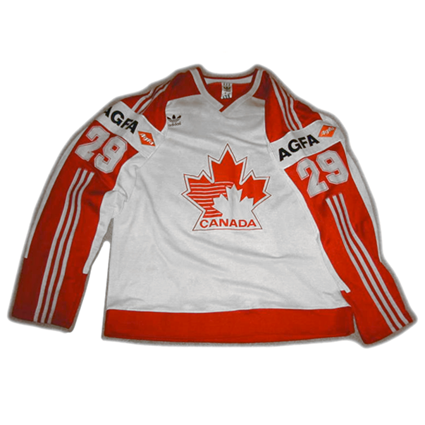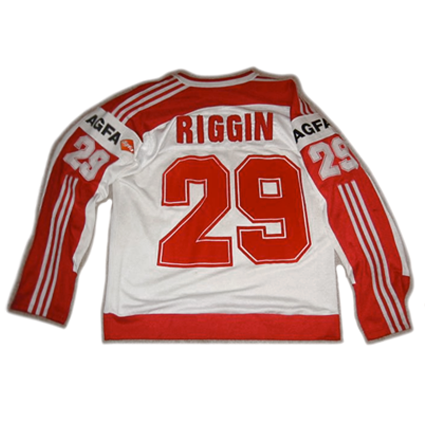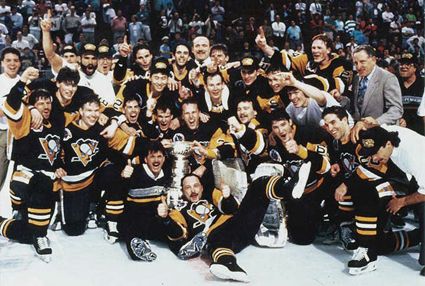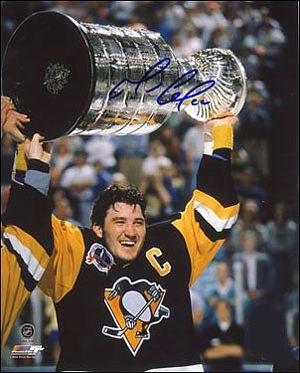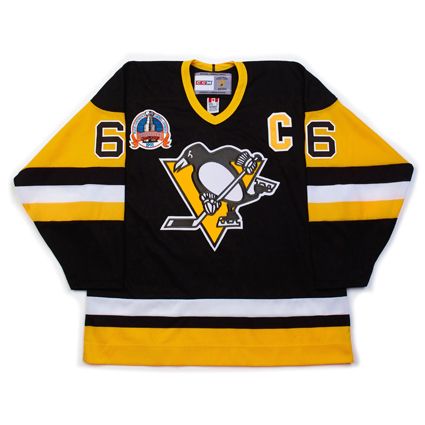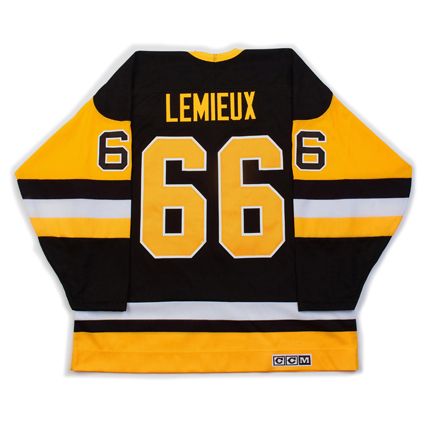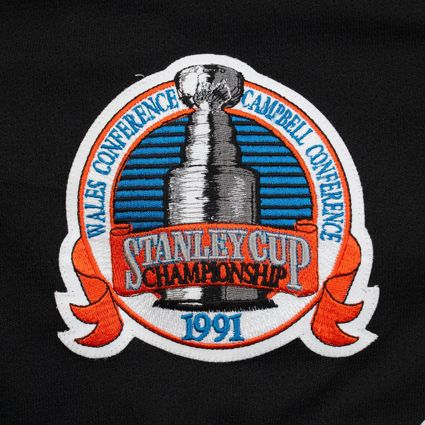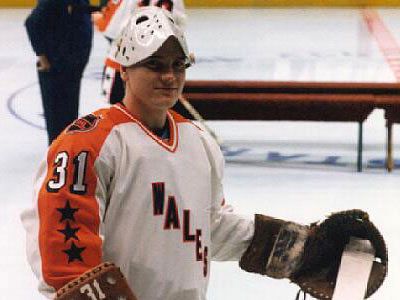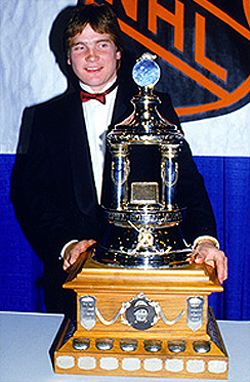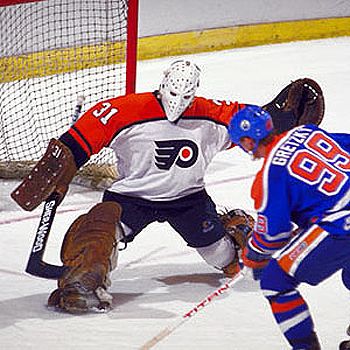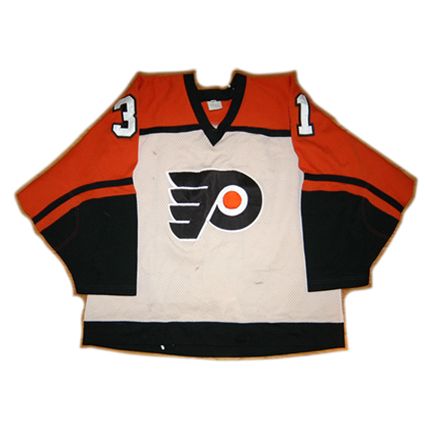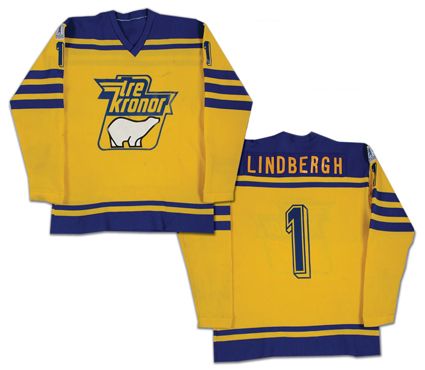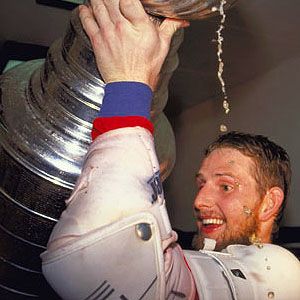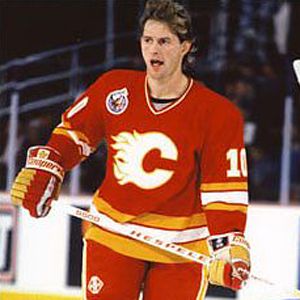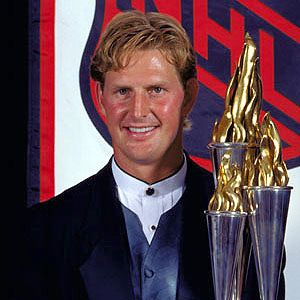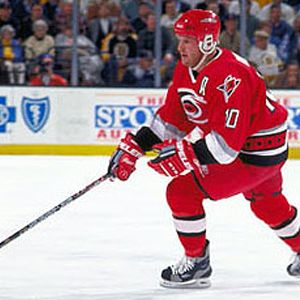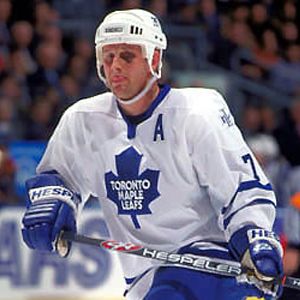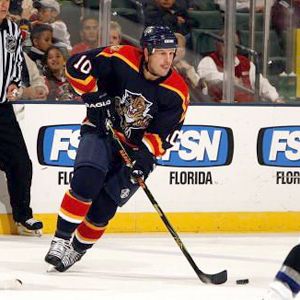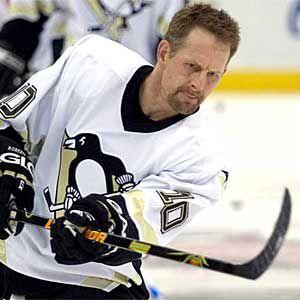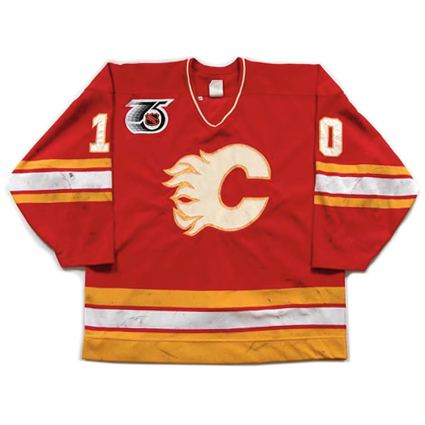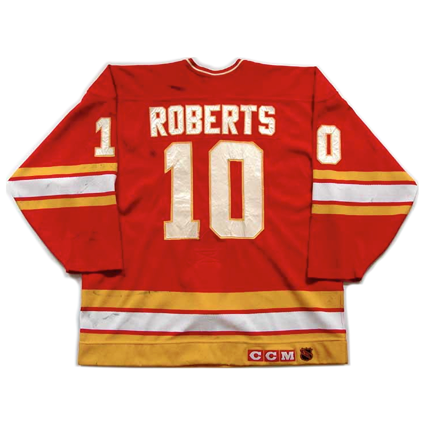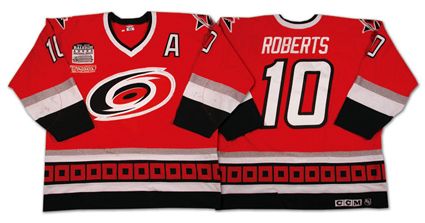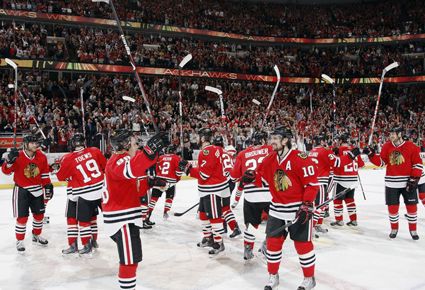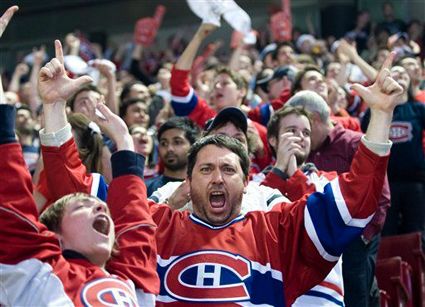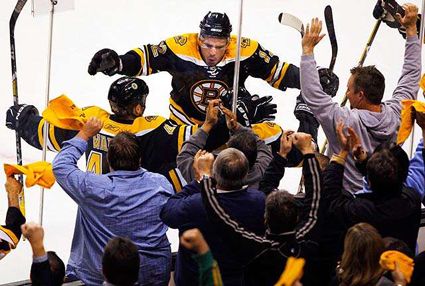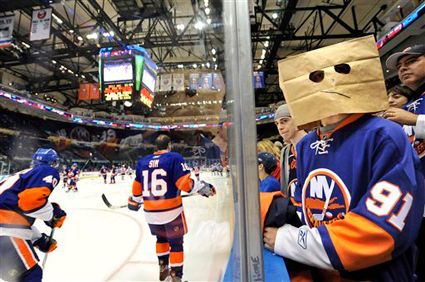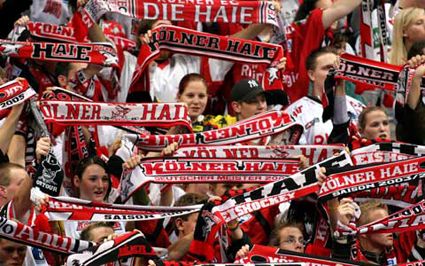Saturday, May 28, 2011
1931-32 Toronto Maple Leafs Red Horner Jersey
Bruising Hall of Fame defenseman George "Red" Horner was born on this date in 1909. He began his hockey career with the Toronto Marlboros of the Ontario Hockey Association in 1926-27, the first of two seasons he would play with the junior club.
Horner's rise to the NHL in 1928 must have set some sort of record, as he played for the junior Marlboros on the evening of Friday, December 21st. The next afternoon he suited up for an amateur team in the stock brokers league, as his day job was as a clerk at a brokerage at the time, and was informed after the game by team owner Conn Smythe, who was in attendance at the amateur game, that he would be suiting up for the Toronto Maple Leafs that evening for their game against the Pittsburgh Pirates, his third game at three different levels in 24 hours!
Unfortunately, Horner broke his hand in his second game which limited him to just 22 games that season. He gave a glimpse of what was to come however, as he was assessed with 30 minutes in penalties that season.
Horner in a Maple Leafs sweater worn from 1927 to 1934
The next season he played in 33 games, which included his first NHL points with a pair of goals and 7 assists to go along with his 96 penalty minutes.
Two seasons later in 1931-32 Horner competed in 42 games and more than doubled his career goal totals up to that point when he found the back of the net 7 times and established a new high in points as well with 16. He was also in the starting lineup on November 12, 1931 when the brand new Maple Leaf Gardens hosted it's first game.
The Maple Leafs advanced to the playoffs that season where they defeated the Chicago Black Hawks 6 goals to 2 in their two-game total-goal series. They advanced to the finals by defeating the Montreal Maroons 4 goals to 3. The Maple Leafs then swept the New York Rangers in three straight games, scoring 6 goals in each contest to win the only Stanley Cup of Horner's career. Horner contributed 2 goals and 4 points in the Maple Leafs 7 playoff games.
The 1932 Stanley Cup champion Toronto Maple Leafs
By the 1932-33 season, Horner had now grown into a man's body and became an even more physical player. He surpassed the 100 penalty minute mark with 144 to lead the league for the first of eight consecutive seasons. In 1933-34 Horner raised his penalty minute total to 146 and set a career high with 11 goals and a new personal best of 21 points.
The 1935-36 season saw Horner break the eight year old league record for penalty minutes held by the legendary Eddie Shore when he was whistled for 167.
Horner with a teammate in the sweaters worn from 1934 to 1937
Two seasons later in 1937-38 Horner set a a career best with 24 points from 4 goals and 24 assists while continuing his streak of leading the league in time in the box.
He was named team captain in 1938 and would play two more seasons for the Maple Leafs before retiring after the 1939-40 season with 490 games played, 42 goals and 110 assists for 152 points and 1,264 career penalty minutes, which was the most in league history and a mark which stood until 1958 until broken by Ted Lindsay. His record of leading the league in penalty minutes for eight straight seasons still stands to this day.
Horner in a Maple Leafs sweater worn from 1938 to the end of his career
During his playing days Horner had the honor of playing in both the 1934 Ace Bailey Benefit Game and the 1937 Howie Morenz Benefit Game, two early All-Star contests that pre-dated the now annual NHL All-Star Game.
Horner was elected to the Hockey Hall of Fame in 1965.
Today's featured jersey is a 1931-32 Toronto Maple Leafs "Red" Horner jersey. The club was renamed the Maple Leafs in the middle of the 1926-27 season after being purchased by Smythe. Their original jerseys were a plain white sweater with a green Maple Leaf, which changed to blue at the start of the 1927-28 season.
They also introduced an early version of today's featured jersey with it's multiple arm and waist stripes as their primary sweater that season, adding the white shoulder striping for the 1930-31 season. This is the style Horner and the Maple Leafs wore when they captured the Stanley Cup in 1932.
Today's video is about the 1932 Stanley Cup champion Toronto Maple Leafs.
Labels:
Horner Red,
Toronto Maple Leafs
Friday, May 27, 2011
2004-05 Nuermberg Ice Tigers Herberts Vasiljevs jersey
A true stalwart of the Latvia National Team, Herberts Vasiljevs was born on this date in 1976 in Riga, Latvia.
His professional career began with the Krefeld Penguins of the German DEL in the 1994-95 season as an 18-year-old.
Vasiljevs came to North America the following season and the right winger had a strong season for the Guelph Storm, scoring 34 goals and 67 points in 85 games. Guelph made it to the Memorial Cup and Vasiljevs contributed 19 points in 16 games.
The 1996-97 season saw him visit the hockey outposts of Knoxville of the ECHL and Port Huron of the Colonial Hockey League for 3 games each although he spent the majority of the season with the Carolina Monarchs of the AHL. On the move once again for 1997-98, he finished third in scoring for the New Haven Beast of the AHL with 66 points in 76 games.
Continuing his travels around the minors, Vasiljevs played for the Kentucky Thoroughblades in 1998-99, averaging a point per game with 76 points in 76 games. He also made his NHL debut that season with 5 games with the Florida Panthers, but failed to score a point.
1999-00 was a similar story for the Latvian, as the majority of his season was again spent in the AHL, this time with the Orlando Solar Bears, playing 73 games and scoring 60 points while seeing action in 7 NHL games with the Atlanta Thrashers, which included his first NHL goal.
He was back with the Solar Bears for 58 games, scoring over 20 goals for the fourth consecutive AHL season with 22 in addition to his 21 games spent with the Thrashers during which he scored 4 goals and 5 assists.
The 2001-02 season saw a change in organizations, as he split time between the Vancouver Canucks for 18 games and their top minor league affiliate, the Manitoba Moose for 31 games.
It proved to be the final NHL games of his career, as he spent the entirety of the 2002-03 season with Manitoba, which in turn were the final games of the North American portion of his career, as Vasiljevs signed with Khabarovsk Amur of the Russian Elite League for 2003-04.
Vasiljevs returned to Germany the following season with the Nuermberg Ice Tigers where he regained his scoring touch with 38 points in 39 games, his highest average per game since 1999.
After 11 seasons of bouncing around from country to country, from the minors to the pros, Vasiljevs found a home - right back where he started in 1994 with Krefeld as an 18-year-old.
At the conclusion of this past 2010-11 season, Vasiljevs, now the captain of the Penguins, has now played for Krefeld for the last six seasons, leading the team in scoring in 2007, 2008, 2010 and 2011. He also been a regular fixture in the top ten in league scoring since 2006-07 when he led the DEL in goal scoring with 30 goals and was named the DEL league MVP. He is currently signed with the club through the 2012-13 season.
While Vasiljevs club teams were an unsettled lot for the first decade of his career, his place on the Latvia National Team was not. He made his first appearance for his country in 1998 at the World Championships. He made three more World Championship appearances in 2000, 2004 and 2005. A busy 2006 saw him make his Olympic debut in February, scoring his first international goal, followed by a highlight for all Latvians, as they hosted the World Championships for the first time in May.
Photo courtesy of Francis Larrede © 2010
He continued his international career, which included becoming the captain of the national team, with consecutive World Championship appearances from 2007 to 2011 including leading the team in scoring in 2009. After a slow start with 5 points in his first six international tournaments, Vasiljevs has now scored 24 points in his last six.
Today's featured jersey is a 2004-05 Nuermberg Ice Tigers Herberts Vasiljevs jersey. This jersey is typical of many European league jerseys with it's numerous sponsorship patches. The grey color however, is rather unusual for a hockey jersey, as they are generally either white or a much bolder color, paticularly in Europe where the common use of dye-sublimation allows for the use of especially bright colors.
Bonus Jersey: Today's bonus jersey is a 2001-02 Manitoba Moose Herberts Vasiljevs jersey as worn during the North American portion of Vasiljevs career while he was trying to become an NHL regular. With their use of the moose antler theme, Manitoba's jerseys have some of the greatest numbers in the history of hockey jerseys.
In today's video segment, Vasiljevs scores in the 2009 World Championships for Latvia. Goals by Latvia against Russia are particularly sweet for the team and their fans taking into account their past political situation.
Thursday, May 26, 2011
1984-85 Washington Capitals Pat Riggin Jersey
Born on this date in 1959, Pat Riggin played his junior hockey with the London Knights from 1975-76 to 1977-78. He was then signed by the Birmingham Bulls of the WHA as one of six underage players in an attempt to gain the upper hand on the NHL, who did not allow players still in their teens to play in the league. Birmingham's strategy earned them the nickname of the "Baby Bulls". The 19-year-old Riggin shared goaltending duties with the oldest player on the club, 38-year-old Ernie Wakely, who was twice Riggin's age.
Following the season the WHA ceased to exist and Riggin was drafted by the Atlanta Flames of the NHL. Riggin split his time in the following 1979-80 season between the Flames and the Birmingham Bulls franchise which became a member of the minor league Central Hockey League.
It would be Riggin's only season in Atlanta, as the franchise relocated to Calgary for the 1980-81 season. He also took over as the number one goaltender, playing in 42 games and going 21-16-4 as well as posting a winning record in the playoffs with a 6-4 mark in 11 games played. He would play one more season with the Flames as his workload increased to 52 games.
Following the 1981-82 season Riggin was traded to the Washington Capitals where he registered three consecutive winning seasons while his workload increased from 38 games to 41 in 1983-84 when he won the Jennings Trophy with Al Jensen, to 57 in 1984-85 which included a career high of 28 wins.
That seasons performance earned Riggin his first opportunity to play in the 1985 World Championships for his native Canada where he earned a silver medal.
He began the 1985-86 season with Washington, but was involved in a swap of goaltenders with the Boston Bruins, who sent Pete Peeters to the Capitals early in the season. Riggin led the Bruins with games played that season with 39, as five different players saw time in the Bruins net that season.
He fell out of favor with the Bruins in 1986-87 and was eventually assigned to the Moncton Golden Flames of the AHL for a time before being traded to the Pittsburgh Penguins in February of 1987. Following the regular season, Canada called once more for the 1987 World Championships, where they finished just out of the medals in fourth.
Riggin began the 1987-88 season with the Penguins, but after 22 games and a 7-8-4 record, was sent to the Muskegon Lumberjacks of the IHL where he played quite well in 18 games, compiling a 13-2-0 record with a goals against average of 2.70 before retiring at the end of the season with a career NHL record of 350 games played and a record of 153-120-52 and a career goals against average of 3.43 and 11 shutouts.
Today's featured jersey is a 1984-85 Washington Capitals Pat Riggin jersey as worn the season Riggin had the best season of his career with 28 wins in 57 games played.
While many may assume the Capitals jerseys remained the same during the early days of the franchise, there were subtle detail changes, which included adding names to the back of the red road jerseys in 1977, changing to single color names beginning in 1979-80, dropping the number of stars on the arms to just four for 1983-84 and 1984-85, adding the fifth star on the arms back in 1985-86 and making the names two colors again in 1987-88 through the end of the lifespan of this classic jersey style until it was replaced with an entirely new set of jerseys, which sported an entirely new identity package consisting of a new logo and all new team colors in 1995-96.
Bonus jersey: Today's bonus jersey is a 1985 Team Canada Pat Riggin jersey as worn in the 1985 World Championships. This jersey is made by Adidas as evidenced by their iconic three stripe motif which runs down the length of the sleeves in addition to the adidas logo on the upper right chest.
We believe Adidas was the first jersey manufacturer to adorn the jerseys at the World Championships with their brand logo, as well as taking it a step farther by incorporating their identity into the design of the jersey itself when they arrived on the scene in 1982.
Tackla of Finland continued that plan in 1988 to 1994, with the final year being with Reebok logos. Nike then entered into a partnership with the IIHF in 1995, which remains in effect to this day.
In today's video section the feisty Riggin gives Swede Pelle Lindbergh of the Philadelphia Flyers the business, but it does not escalate.
Next, Riggin, now with the Penguins, faces a penalty shot by Alan Kerr of the Islanders.
Labels:
Riggin Pat,
Washington Capitals
Wednesday, May 25, 2011
1990-91 Pittsburgh Penguins Mario Lemieux Jersey
In their 24th season, the Pittsburgh Penguins were finally able to win the Stanley Cup on this date in 1991 by crushing the Minnesota North Stars 8-0 to win in 6 games. The Penguins were led by superstar Mario Lemieux and a deep line up featuring Joe Mullen, Mark Recchi, Kevin Stevens, rookie Jaromir Jagr, Larry Murphy, Paul Coffey and goaltender Tom Barasso. As if that roster weren't strong enough on it's own, the Penguins also added Bryan Trottier, a veteran of the New York Islanders recent dynasty to provide veteran leadership. Coaching this deep lineup of talent was "Badger" Bob Johnson in his first year behind the Penguins bench.
The Penguins started the season without Mario Lemieux, who missed the first half of the season recovering from a back injury suffered in February of the previous season. The team got off to a slow start, but with the return of Lemieux, their fortunes improved to the point that they were in playoff contention in 3rd place in their division when March rolled around and they pulled off a big trade that would put them over the top, acquiring Ron Francis from Hartford. With the addition of Francis, the Penguins finished the season 9-3-2 and won their first Division Championship.
In the playoffs they would defeat the New Jersey Devils in 7 games after being down 3 game to 2. They next defeated the Washington Capitals and then the Boston Bruins in 6, after falling behind 2-0 to start the series, to earn the right to face the surprising Minnesota North Stars in the finals.
Minnesota had actually finished the regular season with a dismal 27-39-14 record but came out of nowhere in the playoffs to defeat the President's Trophy winning Chicago Blackhawks in a huge upset, followed by St. Louis and then the defending champion Edmonton Oilers to reach the finals.
Minnesota continued their hot streak and won Game 1 on the road, but the Penguins came back to win game 2 as the series shifted to Minnesota where the Penguins earned a split, tying the series at 2-2. Pittsburgh then won Game 5 at home and slaughtered the North Stars 8-0 to win their first Stanley Cup. Lemeiux was awarded the Conn Smythe Trophy as the playoff MVP.
Today's jersey is a 1990-91 Pittsburgh Penguins Mario Lemieux jersey featuring the 1991 Stanley Cup Finals patch, as worn during that season's Stanley Cup Finals.
When the Penguins arrived on the scene in 1967, they wore powder blue jerseys for their first six years. The shade of blue darkened somewhat in 1973 and lasted until 1977 when an even darker navy blue became the club's primary color.
Then, quite unusually, the Penguins changed to their new color scheme of black and yellow during the middle of the season! The change in colors was an effort to win the goodwill of the fans of Pittsburgh, as both the Pittsburgh Steelers and Pittsburgh Pirates won world championships in both football and baseball in 1979 while wearing black and gold, the colors of the flag of the City of Pittsburgh.
These jerseys would remain in use through the 1991-92 season, which included the Penguins second Stanley Cup championship in a row, before a change to a new set the following year.
Today's video is all the goals from the deciding Game 6 as Pittsburgh dominated the contest to win the cup in as convincing a fashion as has ever happened.
Labels:
Lemieux Mario,
Pittsburgh Penguins
Tuesday, May 24, 2011
1984-85 Philadelphia Flyers Pelle Lindbergh Jersey
Born on this date in 1959 in Stockholm, Sweden Per-Eric "Pelle" Lindbergh made his debut with Hammarby IF of Stockholm's junior team in 1975 and made his international debut for the Sweden National Team that same season in the European Junior Championships earning the silver medal as well as the award for Best Goaltender. A second season with Hammarby as well as a second European Junior Championship appearance followed in 1976-77, which resulted in a gold medal as well as a second Best Goaltender award at the 1977 EJC.
Lindbergh in goal for Hammarby. Note the
Flyers logos on his mask even then.
His first season with Hammarby IF in Sweden's Division 1 in 1977-78 was highlighted with four games played at the newly promoted World Junior Championships, backstopping Sweden to a silver medal. At the time, NHL players had begun appearing in the World Championships, beginning in 1976. International Ice Hockey Federation officials began to fear that true amateur and younger players were losing their places they traditionally held with teams at the World Championships, so the Under-20 Junior Championships were elevated to full world championship status in 1977.
A second season with Hammarby IF in Division 1 in 1978-79 saw him named Best Goaltender at the 1979 World Junior Championships, where Sweden would win the bronze medal, followed by making his debut with the Sweden National Team at the senior level at that year's World Championships in Moscow, helping Sweden to a bronze medal finish. He was also drafted by the Philadelphia Flyers 35th overall in the 1979 NHL Entry Draft and the second goaltender and second European taken that year.
1979-80 was a breakthrough season for the young netminder, as he would take over the starting role in goal for AIK Stockholm in the Elitserien, Sweden's highest professional level, appearing in 32 games and being named to the 1980 Swedish Olympic Team. Lindbergh would appear in five of Sweden's seven games as Sweden won the bronze medal.
He would make his NHL debut with the Maine Mariners of the American Hockey League in 1980-81, winning the Hap Homes Award, the Les Cunningham Rookie of the Year Award and the Red Garrett Most Valuable Player Award honors after a stellar 31-14-5 record in the regular season and a 10-7 mark in the playoffs as Maine reached the Calder Cup Finals.
Prior to the next season, Lindbergh was named to the Sweden National Team's roster for the 1981 Canada Cup tournament. He would split time in 1981-82 between the Mariners (25 games) and make his NHL debut with the Flyers with eight games, posting a 2-4-2 record.
The departure of Pete Peeters for the Boston Bruins opened up more time for Lindbergh in 1982-83, as he became the number one goaltender for the Flyers, appearing in 40 games, posting a 23-13-3 record and was named to the NHL All-Rookie Team and played in his first NHL All-Star Game. Following the NHL season Lindbergh played in his second World Championships for Sweden and yet another medal, this time a bronze, his seventh international medal.
Lindbergh at his first NHL All-Star Game in 1983.
Bob Froese took the majority of the starts in Philadelphia in 1983-84 with 48 games played, with Lindbergh finishing with a 16-13-3 mark in 36 appearances.
The high point of Lindbergh's career came in the 1984-85 season, when Lindbergh saw the bulk of the workload, seeing action in 65 games while going 40-17-7 to lead the league in wins and help the Flyers reach the Stanley Cup Finals. His outstanding play was rewarded with his second NHL All-Star Game appearance as well as being named the recipient of the 1985 Vezina Trophy, the first European goaltender in NHL history to ever win the award.
Lindbergh with the Vezina Trophy.
Lindbergh also became the first goaltender to bring a water bottle with him on the ice during a game to combat severe dehydration that plagued him, a now accepted and regular practice.
In addition, Lindbergh was also known for his stark white goalie mask used during a period when nearly all goalie masks were adorned with increasingly elaborate paint schemes to reflect either the team's identity or their individual personality. The mask was a replica of his idol and goaltending coach, former Flyer goalie Bernie Parent.
Following his Vezina Trophy winning season, Lindbergh signed a six year contract with the Flyers and bought himself a 565 horsepower, customized Porsche 930 Turbo. He began the 1985-86 season in good form, winning six of his first eight starts, but tragedy struck when Lindbergh crashed his car while driving impaired on November 10, 1985, leaving him brain-dead and his two passengers seriously injured. Lindbergh was kept on life support long enough for his father to arrive from Sweden to join Lindbergh's mother, who was already in the United States on a visit, to say goodbye and then make the final decision to donate his organs and end life support on November 12th. Lindbergh was just 26 years old.
His death stunned is teammates, the city of Philadelphia and the nation of Sweden. Fans then made Lindbergh the top vote getter for the 1986 NHL All-Star Game, the first time a player was chosen posthumously for an all-team in North American sports.
While Lindbergh's #31 was never officially retired, no Flyer has worn the number since.
The Flyers created the Pelle Lindbergh Memorial Award in 1994, given annually to the Most Improved Player each season.
For more on the life and career of Pelle Lindbergh, we recommend Pelle Lindbergh: Behind the White Mask .
.
Today's featured jersey is a 1984-85 Philadelphia Flyers Pelle Lindbergh jersey from the season he recorded his career high 40 wins. The Flyers adopted this modernized version of their classic jersey in 1982-83, Lindbergh's second season with Philadelphia. It featured the addition of more black trim to separate the orange arm coloring from the white of the body and was made by Sandow SK. The following season the jersey remained the same, but was now made by CCM. One season later the Flyers jerseys again were rebranded, this time by Eagle.
This style Flyers jersey was essentially carved in stone, as it remained unchanged through the 2006-07 season after which it was replaced by the Reebok Edge jersey, sadly doing in an iconic jersey after 20 years of service.
Bonus jersey: Today's bonus jersey is a 1979 Sweden National Team Pelle Lindbergh jersey as worn in the 1979 World Junior Tournament which took place in Sweden. Lindbergh was named the Best Goaltender and helped Sweden earn a bronze medal that year.
This jersey is from a period of time in the late 70's/early 80's when Sweden moved away from their traditional three crowns logo and instead sports the phrase "Tre Kronor", which translates to "Three Crowns".
While there are numerous Lindbergh game highlights, news reports and tributes available, we chose to feature this excellent tribute today.
Labels:
Lindbergh Pelle,
Philadelphia Flyers
Monday, May 23, 2011
1991-92 Calgary Flames Gary Roberts Jersey
Gary Roberts, born on this date in 1966, began his road to the NHL with the Ottawa 67's of the OHL in 1982-83. After his second season, in which he scored 57 points in 48 games and impressed with his toughness, acquiring 144 penalty minutes, Roberts was drafted 12th overall in the 1984 NHL Entry Draft. Additionally, Ottawa won the OHL playoff championship and advanced to the Memorial Cup, which they were able to win following a 7-2 dismantling of the Kitchener Rangers in the final.
Now full of confidence after having been drafted as well as winning the championship the previous year, Roberts elevated his game to the next level in 1984-85 when he scored 44 goals and 106 points while amassing 186 penalty minutes in 59 games, establishing himself as an elite NHL prospect.
Roberts began the 1985-86 season with Ottawa bit was traded to the Guelph Platers for the second half of the season. Roberts was the missing piece for Guelph, as he racked up 31 points in 20 playoff games to lead the Paters to the second Memorial Cup title of his career.
Roberts turned professional the next season with the Moncton Golden Flames of the AHL. He was called up to the Calgary Flames, which included scoring a goal in his game. He bounced up and down between the AHL and NHL in 1986-87, eventually totaling 15 points in 32 games with Calgary.
During his second full season with the Flames in 1988-89, Roberts and the Flames went on a run through the playoffs which cumulated in their winning the only Stanley Cup championship in Flames history. In 22 games, Roberts contributed 12 points.
Roberts game took a big leap forward the following season, as he nearly doubled his previous season's offensive totals with 39 goals and 72 points, while his toughness was not affected, as he finished with over 200 penalty minutes for the third of five consecutive seasons.
In 1991-92 Roberts reached the pinnacle of his offensive production with the only 50 goal season of his career with 53 on his way to totaling a career best 90 points to lead the Flames in scoring, no easy feat on a roster with Al MacInnis, Theo Fleury, Sergei Makarov and Joe Nieuwendyk. Thanks to his 207 penalty minutes, Roberts became the first player in NHL history to ever score 50 goals and have over 200 penalty minutes in one season, essentially creating the concept of the modern "power forward" singlehandedly.
In the 1993-94 season Roberts nearly equalled his career high when he hit 84 points in 73 games. During the season he blocked a slapshot while killing a penalty, which broke his thumb in seven places, but in a testament to his ongoing toughness, he missed just one game and scored two goals in his return.
Injuries did get the better of Roberts when he suffered severe nerve damage in his neck, which limited him to just 8 games of the 1994-95 season. His recovery time continued into the 1995-96 season as he require multiple surgeries to address his condition. Finally, he returned in January of 1996 and scored a goal in his first game back. He would play in the Flames next 35 games, changing from center to wing to avoid additional contact for his fragile neck, and score 22 goals and 42 points before once again injuring his neck and missing the remainder of the season as well as the 1996 playoffs.
With the risk of paralysis from any further injury a very real possiblity, Roberts announced his retirement from the NHL in June of 1996, just two days before receiving the Masterton Trophy for his comeback to hockey after nearly a year away earlier in the season.
Roberts never actually signed his retirement papers however, and continued to work out and rehabilitate his neck while missing the 1996-97 season. He announced himself fit and pain free in January of 1997 and was offered a contract by the Flames for the 1997-98 season. Roberts let the Flames know that while he was interested in returning to the NHL, it would be only if he were traded to an Eastern Conference club.
A deal was struck with the Carolina Hurricanes in August and Roberts was able to successfully pass his physical and return to action for the 1997-98 season. He would play three seasons with the Hurricanes, playing 61, 77 and 69 games. He would not return to his previous offensive totals, as his game, as well as the overall style of play in the NHL had changed from the wide open style of his 90 point season eight seasons earlier, but he was still and effective two-way player who consistently scored between 42 and 53 points during the second phase of his career.
Following his three seasons with the Hurricanes, Roberts signed as a free agent with the Toronto Maple Leafs, where his 53 points in 2000-01 were good for second on the club behind perennial leader Mats Sundin while leading the team in hits with 206.
During the 2001-02 playoffs, Roberts led the Maple Leafs with 19 points in 19 games as Toronto made it to the conference finals.
He missed the first four months of the 2002-03 season following shoulder surgeries during the offseason. After playing for a month, he missed another month with a groin injury before returning for the playoffs.
He bounced back with 72 games in 2003-04, which included the 1,000th game of his career on January 13, 2004. That season he was also reunited with former Flames teammate Nieuwendyk.
After sitting out the 2004-05 season due to the NHL lockout rather than playing in Europe like many other NHLers, Roberts, along with Nieuwendyk, signed with the Florida Panthers for the resumption of play for the 2005-06 campaign. His season was limited to 58 games, during which he scored 40 points or more for the 13th time in his career.
During his second season in Florida, Roberts, now 40, was traded to the Pittsburgh Penguins for the remainder of the 2006-07 season.
He returned to Pittsburgh for 2007-08, but suffered a broken leg in December. Known league-wide for his toughness and conditioning, Roberts was said to be listed as "questionable" for the next Penguins game by some fans in jest after hearing the news, along the lines of other such Gary Roberts Facts as;
- Gary Roberts sleeps with a pillow under his hockey stick
- Gary Roberts goes grocery shopping at Lowe's
- That's not a chin under Gary Roberts playoff beard, it's another fist
Roberts season was not finished however, and he returned in time to join the Penguins run to the Stanley Cup Finals.
Following the season, Roberts was traded to the Tampa Bay Lightning where he played in 30 games before retiring for good in March of 2009 after 21 seasons, 438 goals, 910 points, 2,560 penalty minutes and one Stanley Cup and a well earned reputation for toughness, perseverance, fitness and longevity.
Today's featured jersey is a 1991-92 Calgary Flames Gary Roberts jersey worn during the season in which Roberts had his only 50 goal season while setting a career record with 90 points.
The Flames wore this jersey from their first season in Calgary through the 1993-94 season, which included the first nine of Robert's ten seasons with the Flames before changing to a new, more modern style for his final season in Calgary prior to his first retirement following the season due to a serious neck condition.
Bonus Jersey: Today's bonus jersey is a 1999-00 Carolina Hurricanes Gary Roberts jersey as worn during his return to the NHL following his first retirement after returning to action after needing 11 months to recover from serious nerve damage to his neck.
This is a rare "triple patch" jersey, which features both the NHL 2000 patch, worn by all teams in honor of the new millennium, as well as the Raleigh Arena Inaugural Season patch on the front of the jersey. When the Whalers moved out of Hartford, the franchise's new arena would take two years to construct, forcing the team to play their first two seasons as the Hurricanes in Greensboro, an hour and a half from their eventual home in Raleigh.
Completed for the 1999-00 season, the club would now move into their new, permanent home and celebrated the move with a celebratory patch.
Also appearing on this jersey, but obscured from view on the left arm in between the sleeve number and secondary shoulder logo, is the Steve Chaisson Memorial patch, worn in memory of former Hurricane Chaisson who died in an automobile accident just after the conclusion of the previous season.
The Hurricanes have worn this jersey since relocating from Hartford in 1997, even maintaining the essentially the same jersey during the switch to the Reebok Edge jerseys in 2007-08.
In today's video section, the 41-year-old Roberts teaches 23 -year-old Ben Eager a lesson about respect.
In this highlight, Roberts scores in triple overtime to win a playoff game for the Maple Leaf in 2002.
Here is Gary Roberts wreaking havoc for Pittsburgh during the 2007-08 season. And don't your forget it.
We're not saying Roberts played for a long time and was really, really tough, but here he is fighting NHL career penalty minute leader Tiger Williams in 1987. We're just sayin'...
Here is an interview with Roberts from April, 2010 with Ron MacLean of Hockey Night in Canada.
Labels:
Calgary Flames,
Carolina Hurricanes,
Roberts Gary
Sunday, May 22, 2011
2010-11 Worldwide Hockey Attendance Report
The Chicago Blackhawks were the most watched team on the planet for the third consecutive season in 2010-11, drawing a total of 878,356 fans for an average of 21,423 fans per game which was 108.7% capacity at the United Center.
The Blackhawks salute the world's largest fanbase
Runners up were the Montreal Canadiens at 21,273 which was 100% capacity at the Bell Centre.
Montreal fans are among the most passionate in the NHL
The Philadelphia Flyers were third with 19,715 per game (101.1%), followed by the Detroit Red Wings, who drew 19,680 on average. The Red Wings are the first team on the list to play to less than 100% capacity at 98.1%. They were however, the road attendance leaders, as the NHL's top drawing card were the only team to average over 18,000 for their road games at 18,224, which was 99.8% capacity.
The Toronto Maple Leafs, (19,354/102.9%), Calgary Flames (19,289/100%), St. Louis Blues (19,150/100%) and Vancouver Canucks (18,860/100%) all played to full houses in positions 5 through 8.
St. Louis stood out though as being a particularly weak draw on the road, playing to the lowest average number of fans as the visiting team at 16,229, which was 88.7% of capacity and one of only two teams under 90%.
Vancouver's fans are unlike any other
The Buffalo Sabres (18,452/98.7%) and Washington Capitals (18,397/100%) rounded out the top ten, while the Ottawa Senators 18,378/99.3%) and Pittsburgh Penguins (18,240/100%) came next, with Pittsburgh aided by their move into the new CONSOL Energy Center as well as hosting the 2011 Winter Classic, which drew 68,111 to Heinz Field.
The New York Rangers (18,108/99.5%), Los Angeles Kings (18,083/97.7%) and Minnesota Wild, playing at less than 100% capacity for the first time in their history (18,012/99.7%) came next in spots 13 through 15.
The Boston Bruins (17,565/100%) and San Jose Sharks (17,562/100%) both played to full houses at 16th and 17th.
The Tampa Bay Lightning were the first of the teams to play to less than 90% capacity in the 19,758 seat St. Pete Times Forum, drawing an average of 17,268, which was just 87.4% capacity.
The last of the NHL teams to play to 100% capacity are the Edmonton Oilers, whose overall attendance was limited by the size of the 36-year-old Rexall Place, which seats just 16,839.
Of the six Canadian NHL franchises, Toronto leads at 102.9% capacity, followed by Vancouver at 100.3%, Calgary, Edmonton and Montreal all at 100% and Ottawa at 99.3%, showing that the passion and interest in the game in Canada is alive and well, making a good case for the relocation of the Atlanta Thrashers to Winnipeg, as reported this week by the Toronto Globe and Mail.
The Carolina Hurricanes (16,415) played to 87.6% capacity, followed by the Nashville Predators at 16,142. While 273 fans less than Carolina, their percentage was notably higher at 94.3%.
The first overseas club makes the list at #22, as traditional European attendance leaders SC Bern easily lead all non-NHL teams with an average of 15,856 (92.6%). Not only do they lead all of Europe in numbers, they are also a well organized and intimidating presence unlike anything seen in North American rinks.
Back to the NHL, the Florida Panthers (15,685/81.5%), Dallas Stars (15,073/81.3%), Colorado Avalanche (14,820/82.3%), New Jersey Devils (14,775/83.8%) and Anaheim Ducks (14,738/85.8%) follow in positions 23 - 27.
Four NHL clubs were beaten by German DEL leaders Eisbaren Berlin (Berlin Polar Bears) at 13,946 (98.2%), another European club whose supporters who put the "fan" in fanatic.
The four clubs with serious attendance issues in the NHL begin with the Columbus Blue Jackets at 13,658/75.3% and the threatened Atlanta Thrashers, whose single, winless playoff appearance in 11 seasons has resulted in an average which has dropped to 13,469/72.6%.
Next is a shocker at #31, the University of Wisconsin Badgers of the WCHA conference of the NCAA, at an average of 13,226 partying, red-clad faithful, outdrawing every professional club in the world outside of the NHL save two, as well as two members of the NHL itself!
Following next on the list is an anomaly in the form of the University of Michigan Wolverines at 12,291, boosted by the record setting Big Chill at the Big House outdoor game which drew a confirmed 104,073.
The troubled Phoenix Coyotes ranked 29th in the NHL and 33rd in the world with 12,188 fans for 71.2%. Also beating an NHL club is the University of North Dakota Fighting Sioux, also of the WCHA at 11,756.
Brining up the rear of the NHL is the New York Islanders, hurt by several factors from their aging Nassau Coliseum, intense fan dissatisfaction with their ownership, their overall poor play since 1994, having missed the playoffs 12 times in the last 16 seasons and not having won a playoff series since 1993 when Al Arbour was still coach, and their unprofessional and unacceptable media situation, as their "flagship" radio station is WRHU, a college station at Hofstra University, which employs various broadcast students as color commentators and sideline reporters! The Islanders trail the pack in the NHL in both average numbers and percentage of capacity figures, with attendance down to 11,059, which is a mere 67.9% of capacity, over 1,000 fans per game less than Phoenix and the only NHL club whose capacity is under 70%.
Some of the Islanders fans who do show up want to keep their presence a secret
Trailing just behind are the Quebec Remparts of the Quebec Major Junior Hockey League at 10,929 to lead all of Canadian junior hockey by a wide margin, 1,980 more than the next closest junior club.
The next ranked team worldwide is the surprising Dynamo Minsk of Belarus, whose brand new arena resulted in an average of 10,538 (70.25%) to lead the predominately Russian KHL, moving them up the European rankings from 61st to 3rd!
The 38th ranked team in the world are the Hershey Bears of the American Hockey League, averaging 9,800 fans per game. After the two German clubs Kolner Haie (Cologne Sharks) at 9,696 and Adler Mannheim (Manheim Eagles) at 9,689, the 41st ranked team is the University of Minnesota Golden Gophers, again of the WCHA, who at 9,544 are down somewhat from their usual 10,000.
Cologne Sharks fans show their support with soccer-style scarves
The Swedish attendance leaders come in at #42 in the form of the Frolunda Indians at 9,378.
Two more KHL clubs, Avanagard Omsk (9,303) and Lokomotiv Yaroslavl (8,998) edge out the London Knights, leaders of the Ontario Hockey League at 8,948. The top Czech and Finnish clubs, HC Pardubice (8,922) and Jokerit Helsinki (8,490) are up next at #46 and #47. The Manitoba Moose of the AHL check in with 8,404 followed by the Western Hockey League leaders, the Calgary Hitmen at 8,263 and SKA St. Petersburg of Russia averages 8,170 to round out the Top 50.
Also of note are #55 Medvescak Zagreb of Croatia, who compete in the top Austrian league at 7,837 and the #58 Chicago Wolves of the AHL at 7,453, an impressive number playing in the top drawing Blackhawks backyard, making Chicago the world leader in hockey attendance over Calgary's Flames and Hitmen, and #59, the Fort Wayne Komets, who lead the Central Hockey League by far with 7,451.
League-wise, the NHL leads with an average of 16,956, followed by the surprising Western Collegiate Hockey Association at 6,730, outdrawing on average every other professional league in the world! The Swiss National League A (6,306) is third overall and the best attended league in Europe followed by Sweden's Elitserien (6,160), Russia's Kontinental Hockey League (5,785), Germany's DEL (5,756), the North American minor league AHL (5,380), the Czech Extraliga (4,936) and the NCAA's Hockey East (4,934), while Finland's SM-liiga rounds out the Top 10 with 4,833.
While the NHL rules the world, one would expect the Russian KHL to have to rank higher up the list, certainly above leagues in Switzerland and Germany and most assuredly higher than a United States collegiate league, to be able to dole out some of the contracts they have lavished on players since the league's formation.
Labels:
Worldwide Attendance Report
Subscribe to:
Comments (Atom)

